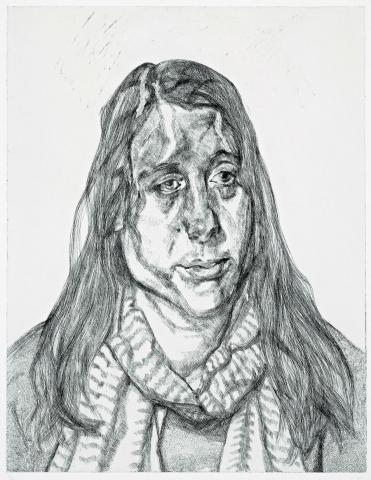PORTRAIT HEAD, 2001
Lucian Freud
etching
59.5 x 46.5 cm
signed with initials and numbered below image
proofed and printed by Marc Balakjian at Studio Prints, London. Published by Matthew Marks Gallery, New York
Matthew Marks Gallery, New York (label attached verso)
Rex Irwin Art Dealer, Sydney
Private collection, Sydney (acquired from the above in 2002)
This image has been widely exhibited throughout the world, most recently, Lucian Freud: The Painter's Etchings, Museum of Modern Art, New York, 2007, 16 December 2007 – 10 March 2008, cat. 61 (another example)
Smee, S., Lucian Freud, 1996 – 2005, Alfred A. Knopf, New York, 2005, no. 44
Figura, S., Lucian Freud: The Painter's Etchings, Museum of Modern Art, New York, 2007, pp. 92 – 138, pl. 61 (illus. another example)
The grandson of eminent psychoanalyst Sigmund Freud, Lucian Freud is widely regarded as the most important figure in contemporary British painting. From his early works (such as the celebrated Interior in Paddington 1951), he rendered his subjects with a meticulous intensity, already displaying the harsh and penetrating observation that would inspire Kenneth Clark's famous description of him as the 'Ingres of Existentialism.' During the late fifties however, he substituted sable for hogs-hair brushes, and accordingly, this miniaturist style gave way to a broader, more robust approach; as Freud himself elucidates, 'I would wish my portraits to be of the people, not like them. Not having the look of the sitter, being them. As far as I am concerned, the paint is the person, I want it to work for me just as flesh does.'1
Today this voracious attitude to his subject is considered the defining feature of Freud's art. Stripping his subjects bare psychologically (and usually literally, as well), he focuses upon the nakedness and vulnerability of human flesh, exposing its blotches, veins and wrinkles to a pitiless, devouring gaze. Dramas without incident or narrative, his portraits are distinctly disturbing in their carnality, thereby encapsulating Freud's belief that 'the task of the artist is to make the human being uncomfortable.'2 As reiterated by Robert Hughes in his highly acclaimed monograph on the artist, the reality pursued in Freud's paintings goes far beyond naturalism: it is both startling and disconcerting, producing some of the most powerful and harrowing images of the twentieth century.3
Executed with the painstaking scrutiny that Freud brings to all his subjects, Portrait Head 2001 is unforgiving in its searching, poignantly highlighting his 'horror of the idyllic' and perception of 'truthfulness as revealing and intrusive, rather than rhyming and soothing'.4 Characteristically square (or almost square), closely cropped and of a scale corresponding to the emotional immediacy of the depiction, the work is not a portrait in the traditional sense of a commemorative statement intended for public consumption, but rather conceived as an intimate exchange between artist and sitter. Accordingly, as with many of his naked portraits (see lot 33), the model here remains quite deliberately unidentified in the title to protect the privacy of both parties, but equally, to focus his audience's attention to the primary subject - his capturing of the truth of real being. As Freud himself elucidates, 'Many people are inclined to look at portraits not for the art in them but to see how they resemble people. This seems to me a profound misunderstanding.'5
1. Freud cited in Lampert, C., Lucian Freud: Recent Work, Whitechapel Art Gallery, London, 1993, p. 6
2. Freud cited at http://richardnagy.com/artists/lucienfreud/
3. Hughes, R., Lucian Freud: Paintings, Thames and Hudson, London, 1997.
4. Freud cited in Feaver, W., Lucian Freud: Paintings and Etchings, Abbot Hall Art Gallery, United Kingdom, 1996, p. 10
5. Freud cited in Cape, J., Freud at Work, Alfred Knopf, New York, 2006, p. 32
VERONICA ANGELATOS
